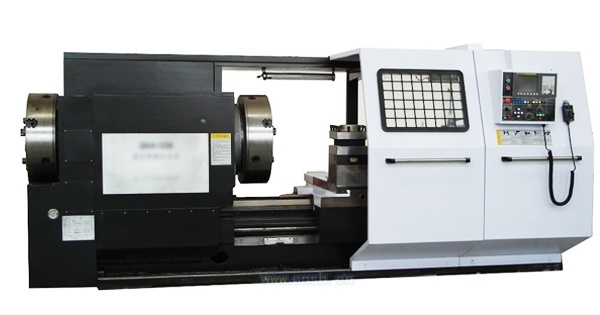Stepper Servo · 17 Years of Expertise
Application
Application of Servo Communication in CNC Machine Tools

Numerical control technology is the technology that enables CNC machines to operate automatically through digital program control. It is widely used in mechanical manufacturing and automation fields, effectively solving problems related to processing a variety of small-batch and complex parts as well as production process automation. With the rapid development of computers and automatic control technology, numerical control technology has been extensively applied to CNC machine tools, robots, and various mechatronic devices. At the same time, the rapid development of the social economy demands rapid advancement and improvement in both theory and application of CNC devices and machinery.
The servo system is an important component of CNC machine tools, often determining the precision and speed indicators of the machine. With technological progress, high-precision, high-performance AC servos have become a new trend in servo system development.
2. Overview
CNC lathes, also known as CNC turning machines, are currently the most widely used and broadly applied type of CNC machine tools domestically. They generally consist of input and output devices, CNC units, servo systems, feedback detection devices, and the main machine tool. As one of the main types of CNC machine tools, they solve most automation processing problems for mechanical parts and have become the primary mechanical processing equipment, holding a very important position in CNC machine tools. They have been widely valued and rapidly developed worldwide for decades.
The servo drive system of CNC machine tools is divided into closed-loop and open-loop types based on the presence or absence of feedback detection units. The basic composition of these two types of servo drive systems is not exactly the same. However, regardless of the type, the actuator and its drive control unit are indispensable. The role of the drive control unit is to convert the feed command into the signal form required by the actuator, which then converts this signal into the corresponding mechanical displacement. For closed-loop servo drive systems, it consists of the actuator, drive control unit, comparison control link, feedback detection unit, and the machine tool. The feedback detection unit detects the actual position of the worktable and feeds it back to the comparison control link, which compares the command signal with the feedback signal and uses their difference as the following error of the servo system to the drive control unit. The drive control unit then drives and controls the actuator to move the worktable. In CNC systems, due to the introduction of computers, the function of the comparison control link is completed by software, leading to some changes in system structure, but it still basically consists of the actuator, feedback detection unit, comparison control link, drive control unit, and machine tool.
3. Prospects for the Application of the CNC Industry
The new trend of high-speed, high-precision machining technology and equipment. With the development of the times, efficiency has become the fundamental factor of effectiveness. We are in a period of rapid development of manufacturing technology, and the machining accuracy of CNC systems directly affects the overall processing time.
The position accuracy of the servo system on CNC machine tools largely determines the machining accuracy of the CNC machine tool. Therefore, position accuracy is an extremely important indicator. To ensure sufficient position accuracy, the servo system of CNC machine tools must correctly select the open-loop amplification factor in the system and impose accuracy requirements on the position detection elements. In closed-loop control systems, it is difficult to distinguish between errors of the detection element itself and deviations in the measured quantity. The accuracy of the feedback detection element often plays a decisive role in the system's accuracy. It can be said that the machining accuracy of CNC machine tools is mainly determined by the accuracy of the detection system.
The smallest displacement measurable by the displacement detection system is called resolution. Resolution depends not only on the detection element itself but also on the resolution or pulse equivalent of the measurement system, generally required to be an order of magnitude higher than the machining accuracy.
The reliability of the servo system of CNC machine tools is one of the main quantitative indicators for evaluating reliability. It is defined as the probability that a product completes its specified functions under specified conditions and within a specified time. For CNC machine tools, specified conditions refer to environmental conditions, working conditions, and modes of operation, such as temperature, humidity, vibration, power supply, interference intensity, and operating procedures. The functions mainly refer to the usage functions of the CNC machine tool, such as various machine functions and servo performance. Mean Time Between Failures (MTBF) refers to the average time from one failure to the next for repairable equipment or systems that can continue working after repair or part replacement. The MTBF of the servo system of CNC machine tools is commonly used as a quantitative indicator of reliability.
With the adoption of microcomputers in CNC devices, the reliability of the servo system of CNC machine tools has greatly improved, making the servo system's reliability relatively prominent. Its failures mainly come from servo components and mechanical transmission parts. Generally, the reliability of hydraulic servo systems is worse than that of electrical servo systems. Electromagnetic components such as solenoid valves and relays have relatively poor reliability and should be replaced with contactless components as much as possible. Currently, due to limitations in component quality, process conditions, and costs, the reliability of CNC machine tools is still not very high.
4. Advantages of Lichuan Servo Systems
1. The high resolution of the servo can effectively meet the high-precision requirements of CNC systems.
2. The servo has a wide response frequency range, effectively adapting to the CNC system's requirements for load changes and rapid response.
3. The servo provides rich parameter settings. By setting electronic gear ratios, frequency division coefficients, S-curve, gain filtering parameters, etc., it can effectively cooperate with the upper computer system to complete processing.
4. The servo has high steady-state accuracy at low speeds and a wide speed regulation range, which can meet the speed requirements of some special industries.
5. The servo has good reliability, can be used in various harsh environments, and effectively improves system stability and anti-interference capability.
5. Conclusion
Using Lichuan AC servo in CNC lathes can achieve the designed performance of CNC machine tools. The feed axis features rapid start and stop, smooth operation, and improves cutting accuracy and efficiency.
Shenzhen Lichuan Electric Co., Ltd.
Technical Support
Engineer Peng:+86-135-3098-8140
Engineer Xie:86-159-0755-7836
Engineer Rao:86-180-2520-1553
Engineer Zuo:86-180-2901-2526

WeChat Public Account

Douyin ID

Official Website Mobile Version
Sorry,当前栏目暂无内容!
您可以查看其他栏目或返回 首页
Sorry,The current column has no content!
You can view other columns or return Home


 WeChat
WeChat